
An unfinished building serves as one of Mexico City’s most important landmarks.
The Monument to the Revolution is the legacy of famous art deco artist Carlos Obregón Santacilia. It is one of the many landmarks across Mexico that are tantamount to its capital. Behind its symbolism, lies the history of its construction.
How did the Monument come to be?
Former President Porfirio Díaz decreed the construction of a “Legislative Palace” in a French style in the early 1900s. Émile Bénard, a French architect, would have been responsible for constructing the place, but the project stopped when the Mexican Revolution deposed Díaz in 1911.
“Don Porfirio Díaz started the project at the hands of a French Architect,” said Ricardo Cañas, a Veracruz historian. “It was going to be a Legislative Palace, akin to the Capitol Buildings of Cuba or the U.S.A., but time was not on their side. When Díaz was overthrown, the project was abandoned. Years later, the new administrations rescued it, resulting in the Monument we know nowadays.”
The work restarted under the presidency of Francisco I. Madero, but stopped once again when he died. Bénard himself returned to Mexico, intending to use the steel structure, which had worn down over the years. President Álvaro Obregón later decided to resume the project, rechristening it as “Panteón a los Héroes” (Heroes pantheon). However, after Obregón’s murder in 1928 and Bénard’s death the following year, the project fell into obscurity.
However, Carlos Obregón Santacilia decided to step in. Along with the engineer Albero J. Pani, he took advantage of the infrastructure to build the now-famous Monument to the Mexican Revolution.

They had to convince President Abelardo Rodriguez and “El Jefe Máximo,” ex-President Plutarco Elías Calles. The adaptation of the old structure lasted from 1933 to 1938.
Obregón Santacilia managed to give it a “sober art deco” style with his artistic hand. The remodeling took around 360 million pesos ($17.8 million) and has had only one renovation since its inauguration in 1938, which was done in November 2010 to commemorate the Mexican Revolution’s centennial anniversary.
However, the National Museum of the Revolution and its mausoleum needed restorations to avoid falling victim to the massive earthquakes that have hit the city. The overlook, however, reopened to the public, along with its transparent elevator.
“Beyond a shadow of a doubt, we are talking about a monument that raises Mexican patriotism,” said Cañas. “It does not only represent the history of conflict of the Revolution itself, but it also serves as a meeting point for citizens and celebrations for the whole of Mexico. Every Mexican must visit at least once to see the symbolism and nationalism behind it.”
While some restrictions have been set amid the coronavirus pandemic, Mexico City’s administration now uses the site for social and cultural events, such as concerts, art festivals and book fairs.
(Translated and edited by Mario Vázquez. Edited by Carlin Becker.)
The post The Monument To The Revolution: A Landmark That Adapted With The Times appeared first on Zenger News.
